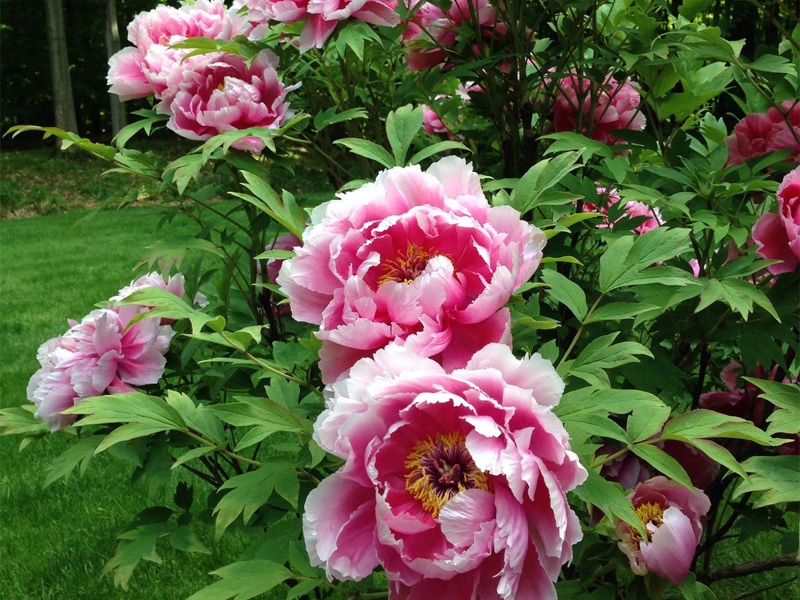
Appearance: The peony cherry is a small deciduous tree with a height of 3-6 meters. The bark is purplish-brown, smooth and glossy, with transverse skin holes. Slender, grayish brown, green shoots, pubescent. Leaf blade ovate to ovate-elliptic, 5-12 cm long, 3-5 cm wide, apex acuminate or caudal, base rounded, margin sharply double serrated, tooth tip with small glands, dark green above, glabrous, light green below, sparsely pilose along veins. The petiole is 0.8-1.5 cm long, pubescent, with 2-4 glands on the tip. Corymbose, with 3-6 flowers, first leaves open, peduncle very short; Flowers 2-2.5 cm in diameter; Calyx tube campanulate, pubescent, sepals triangular ovate, apex acute or acuminate, margin glandular teeth; Petals white or pink, obovate, apex concave; Stamens 30-35, slightly shorter than petals; Style subequal to stamen, glabrous. Drupes subglobular, 0.9-1.3 cm in diameter, red to purplish black, slightly ribbed.
Plant family Genus: Rose.
Extraction parts: The main extraction parts are fruits, which contain unique flavor substances and nutrients; Flowers can also be used as extraction sites in some special applications to extract aromatic substances.
Extraction method:
Fruit extraction: For the extraction of components in the fruit, cherry juice is commonly obtained by pressing method, and further concentrated and purified can obtain the extract rich in nutrients. If the volatile aroma components in the fruit are extracted, steam distillation or supercritical carbon dioxide extraction can be used.
Flower extraction: When extracting the aromatic substances of flowers, steam distillation method is used, fresh flowers are put into the distillation equipment, and the volatile components are brought out by water vapor, and the essential oil is obtained by condensation, oil and water separation; Solvent extraction can also be used to dissolve the aroma substance through a suitable solvent, and then remove the solvent to obtain an extract or a net oil.
Main chemical composition: The fruit is rich in vitamin C, vitamin E, carotenoids, anthocyanins, bioactive phenolic compounds (such as catechin, epicatechin, p-coumaric acid, etc.), but also rich in minerals, such as potassium, iron, calcium and so on. The volatile components of flowers mainly include terpenes, alcohols, esters, etc., which give flowers a unique aroma.
Main origin: Originated in China, mainly distributed in Shandong, Henan, Anhui, Jiangsu, Zhejiang, Hubei, Sichuan, Shaanxi and other places. Yantai in Shandong Province and Dalian in Liaoning Province are important cherry producing areas in China. The climate and soil conditions in these areas are suitable for the growth of peony cherry, and the fruit produced is of good quality.
Note:
Fruit: With sweet and sour fruit notes, fresh and natural, with a strong cherry unique aroma, sweet with a slight hint of sour breath.
Flowers: The fragrance of flowers is relatively elegant, belongs to the fresh floral tone, with a touch of sweetness, giving people a soft, comfortable feeling.
Aroma concentration:
Fruit: Rich aroma, especially ripe fruit, can smell its sweet and sour aroma at a certain distance.
Flowers: Relatively light aroma, moderate volatility, need to be close to smell its fragrance clearly.
Suitable essential oils:
Lavender essential oil: Combined with peony cherry fruit extract or essential oil, it adds a fresh fruit aroma while soothing and relaxing. It can be used in aromatherapy to create a warm atmosphere and help relax the body and mind.
Rose essential oil: The combination of the two can create a romantic atmosphere, can be used in skin care products, combining the nutritional content of cherries with the beauty benefits of roses to nourish the skin.
Peppermint essential oil: With peony cherry aroma, it can create a unique smell of cool and refreshing, which can be used in summer to relieve dry heat and refresh the mind.
Functional characteristics:
Fruit: With antioxidant, anti-inflammatory, beauty, promote digestion, enhance immunity and other effects. Antioxidants such as anthocyanins and vitamins can remove free radicals in the body and delay aging. Rich dietary fiber helps to promote intestinal motility.
Flowers: The aroma of flowers has a soothing effect, which can relieve anxiety, tension and other bad emotions.
Common application:
Muscle conditioning: Fruit extract can be taken internally to supplement nutrition, promote body recovery, and indirectly help repair muscles after exercise; Diluted flower essential oil can be used for massage, and its soothing aroma relaxes the body and mind and indirectly relieves muscle tension.
Immune system: Eating peony cherry fruit or drinking drinks made from it can supplement nutrition and enhance body immunity; Inhaling the aroma of flowers through aromatherapy, regulating mood, can also have a positive impact on the immune system to a certain extent.
Nervous system: The sweet and sour taste of cherry fruit can stimulate taste nerves and bring pleasure; Flower aromas stimulate olfactory nerves, relieve stress and fatigue, and improve mental state.
Taboo to use:
People with allergies: People who are allergic to cherries may have allergic reactions such as mouth tingling, skin rashes, and breathing difficulties. Caution should be exercised when consuming or touching related products, and allergy tests should be conducted before use.
Diabetic patients: fruit sugar content is relatively high, diabetic patients need to control the amount of food.
Too much stomach acid: cherry fruit is acidic, and eating too much stomach acid may aggravate stomach discomfort.
